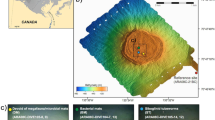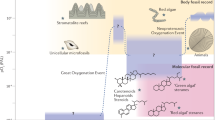Abstract
Modern and ancient sediments contain a multiplicity of organic compounds which record a partial history of the organisms that contributed them1. Interpretation of this record depends on the knowledge of links between the molecular markets and their biological, notably microbial, sources. This goal is made difficult by the complexity of modern sediment communities and the general lack of studies which directly tackle the relationships between the microbial inhabitants of natural systems and their associated organic compounds. We now report the first direct comparison between isopranyl ether-linked lipids in hot-spring microbial mats and the observed populations of archaebacteria. The particular mats examined are from Yellowstone National Park and may represent modern analogues of Precambrian communities preserved as stromatolites2,3. As relatively simple microbial systems, they are suitable for validating specific molecular markers as indictors of microbial populations within a natural community. We find that the phytanyl and biphytanyl ethers reflect the measured distribution of methanogenic archaebacteria.
This is a preview of subscription content, access via your institution
Access options
Subscribe to this journal
Receive 51 print issues and online access
$199.00 per year
only $3.90 per issue
Buy this article
- Purchase on Springer Link
- Instant access to full article PDF
Prices may be subject to local taxes which are calculated during checkout
Similar content being viewed by others
References
Mackenzie, A. S., Brassell, S. C., Eglinton, G. & Maxwell, J. R. Science 217, 491–504 (1982).
Walter, M. R., Bauld, J. & Brock, T. D. Science 178, 402–405 (1972).
Awramik, S. M. in Microbial Mats: Stromatolites (eds Cohen, Y., Castenholz, R. W., Halvorson, H. O.) 1–22 (Liss, New York, 1984).
Robinson, N., Eglinton, G., Brassell, S. C. & Cranwell, P. A. Nature 308, 439–441 (1984).
Langworthy, T. A., Tornabene, T. G. & Holzer, G. Zbl. Bakt. Hyg., I. Abt. Orig. C3, 228–244 (1982).
Woese, C. R. Scient. Am. 224, 98–122 (1981).
Woese, C. R. Zbl. Bakt. Hyg., I. Abt. Orig. C3, 1–17 (1982).
Fox, G. E. et al. Science 209, 457–463 (1980).
Brassell, S. C., Wardroper, A. M. K., Thomson, I. D., Maxwell, J. R. & Eglinton, G. Nature 290, 693–696 (1981).
DeRosa, M., Gambacorta, A., Nicolaus, B. & Grant, W. D. J. Gen. Microbiol. 129, 2333–2337 (1983).
Zillig, W., Schnabel, R. & Tu, J. Naturwissenschaften 69, 197–204 (1982).
Chappe, B., Albrecht, P. & Michaelis, W. Science 217, 65–66 (1982).
Ourisson, G., Albrecht, P., Rohmer, M. Trends Biochem. Sci. 7, 236–239 (1982).
White, D. C., Bobbie, R. J., King, J. D., Nickels, J. & Amoe, P. in Methodology for Biomass Determinations and Microbial Activities in Sediments (eds Litchfield, C. D. & Syfried, P. L.) 87–103 (American Society Testing Materials, 1979).
Martz, R. F., Sebacher, D. I. & White, D. C. J. Microbiol. Meth. 1, 53–61 (1983).
Ward, D. M., Beck, E., Revsbech, N. P., Sandbeck, K. A. & Winfrey, M. R. in Microbial Mats: Stromatolites (eds Cohen, Y., Castenholz, R. W. & Halvorson, H. O.) 191–214 (Liss, New York, 1984).
Chappe, B., Michaelis, W. & Albrecht, P. in Advances in Organic Geochemistry (eds Douglas, A. G. & Maxwell, J. R.) 265–274 (Pergamon, Oxford, 1980).
Brassell, S. C., Gowar, A. P. & Eglinton, G. in Advances in Organic Geochemistry (eds Douglas, A. G. & Maxwell, J. R.) 421–426 (Pergamon, Oxford, 1980).
Ward, D. M. Appl. Envir. Microbiol. 35, 1019–1026 (1978).
Sandbeck, K. A. & Ward, D. M. Appl. Envir. Microbiol. 44, 844–851 (1982).
DeRosa, M., Esposito, E., Gambacorta, A., Nicolaus, B. & Bu'Lock, J. D. Phytochemistry 19, 827–831 (1980).
Ward, D. M. & Olson, G. J. Appl. Envir. Microbiol. 40, 67–74 (1980).
Giani, D., Giani, L., Cohen, Y. & Krumbein, W. E. FEMS Microbiol. Lett. 25, 219–224 ( 1984).
Ward, D. M., Winfrey, M. R. Adv. Aquat. Microbiol. (in the press).
Brock, T. D. Thermophilic Microorganisms and Life at High Temperature 92–179 (Springer, Berlin 1978).
Murphy, M. T. J. in Organic Geochemistry (eds Eglinton, G. & Murphy, M. T. J.) 74–88 (Springer, Berlin, 1969).
Revsbech, N. P. & Ward, D. M. Appl Envir. Microbiol 48, 270–275 (1984).
Author information
Authors and Affiliations
Rights and permissions
About this article
Cite this article
Ward, D., Brassell, S. & Eglinton, G. Archaebacterial lipids in hot-spring microbial mats. Nature 318, 656–659 (1985). https://doi.org/10.1038/318656a0
Received:
Accepted:
Issue Date:
DOI: https://doi.org/10.1038/318656a0
This article is cited by
Comments
By submitting a comment you agree to abide by our Terms and Community Guidelines. If you find something abusive or that does not comply with our terms or guidelines please flag it as inappropriate.



